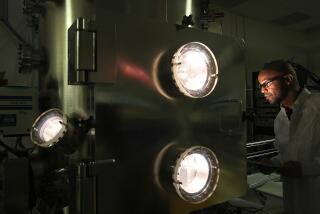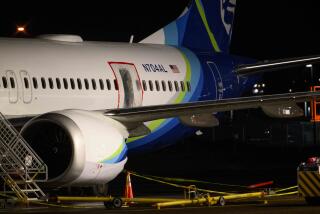Women are increasingly ascending to top posts at aerospace firms
At a time when federal budget cuts are reshaping the nation’s aerospace industry, a far different makeover is underway in the executive suites of some of the country’s biggest defense contractors.
Lockheed Martin Corp., the world’s largest defense firm, announced this month that electronics whiz Marillyn A. Hewson would become chief executive — the first woman to take on that role at the company.
The move came abruptly after the Bethesda, Md., company’s incoming chief executive, Christopher E. Kubasik, was forced out after an ethics investigation confirmed he had a “close personal relationship” with a subordinate employee.
It was an announcement that might have drawn much greater attention from the nation’s defense establishment in Washington if it hadn’t come the same day CIA Director David Petraeus suddenly resigned amid headline-rich reports of an extramarital affair.
After all, no aerospace firm so large — or influential — has ever been run by a woman. Hewson’s promotion followed the summer announcement that Phebe Novakovic would take over as chief executive at General Dynamics, the nation’s fifth-largest defense firm, in Fairfax, Va.
Both take over the top posts Jan. 1, as female engineers, scientists and managers who joined the industry during the Cold War are rising to prominence in a staid industry long dominated by men. Although women have climbed to the top of other industries for decades, aerospace has gone without women at the top until recent years.
“The ascension of women like Marillyn Hewson and Phebe Novakovic to the top of the corporate ladder suggests that while the glass ceiling in aerospace and defense may not have been entirely shattered, it’s certainly become more transparent,” said Marion Blakey, chief executive of the Aerospace Industries Assn. trade group.
Come Jan. 1, there will be a record 21 women who serve as chief executives of firms on the Fortune 500 list of the nation’s largest public companies, including Hewson and Novakovic.
Deborah Soon, senior vice president of strategy at Catalyst, a nonprofit organization that tracks the progress of women in the business world, said parity is still a long way off.
“We look forward to the day when a woman leading an aerospace company is no longer news,” she said.
Other women in the industry are rocketing to the top as well. By next year, six women will sit on aerospace giant Northrop Grumman Corp.’s 14-member senior management team. This month, Boeing Co. shook up its executive ranks and named seven people to leadership roles — five of whom are women.
It’s a big shift from the boy’s club culture that once pervaded the aerospace business after World War II, said industry pioneer Simon Ramo, 99.
“At the time, for all practical purposes, prejudice against women was supreme,” said Ramo, co-founder of former aerospace giant TRW Inc., now part of Northrop. “Things have definitely changed.”
A main reason for the male predominance and evolving shift, experts say, is that most aerospace leaders have risen through the science and engineering ranks, which has been populated mostly by men. According to the National Science Foundation’s most recent data, women make up about 27% of the 4.9 million people working in science and engineering. In 1993, women made up 22% of the 3.2 million people in those fields.
Industry experts do not expect a dramatic change in the way the companies are run. Especially at a time when U.S. military spending — which grew at double-digit percentage rates after the Sept. 11, 2001, terrorist attacks — is expected to decline $487 billion over the next decade.
“Although the demographics are shifting, the basic behavior of the industry will largely remain the same,” said Loren Thompson, a defense policy analyst with the Lexington Institute. “The metrics by which the modern defense industry is judged are sales numbers. That’s not going to change whether the chief executive is a man or a woman.”
The promotions of these new top executives has been greeted with enthusiasm and a bit of curiosity. But no group seems more pleased than other women executives who now see one of their own running the place.
“I do believe women’s roles have shifted significantly in the more than three decades that I have been in aerospace,” said Lillian Ryals, vice president of the Mitre Corp., a nonprofit government contractor. “It is not just our numbers that have grown, but also our reach and influence across the sector, from the civil aerospace industry to our ranks on the military side, from aviation to space.”
Lockheed’s Hewson built her reputation in a variety of business sectors. In her most recent assignment, she made the company’s sprawling electronic systems business the most profitable unit for Lockheed, better known for building fighter jets, Navy warships and spy satellites.
Hewson, 58, grew up in a home that had strong ties to the military. Her parents met at Fort Riley, Kan., both supporting World War II efforts. She earned her bachelor’s degree in business administration and a master’s in economics from the University of Alabama.
“When I walked into Lockheed’s Marietta facility in 1983, saw all those airplanes on the production line, I was hooked,” she said, referring to the company’s Georgia plant.
Soon, Hewson will take charge of a company that employs 120,000 people worldwide, about 25% of whom are women. The company posted net sales of $46.5 billion in 2011.
“Regardless of gender, each of us brings our unique perspective and collection of experiences to our roles and contributes to the success of the organization,” she said.
General Dynamics’ Novakovic, 55, previously oversaw the company’s marine systems group, which includes the sprawling ship building operations Bath Iron Works in Maine and Nassco in San Diego.
Until now, Linda Hudson, 62, has been the most powerful woman in the global defense industry. Dubbed the “first lady of defense” by Washingtonian magazine, she was named to head the U.S. unit of British military contractor BAE Systems Inc. in 2009.
“I grew up in Central Florida in the middle of the space race, watching the Mercury, Gemini and Apollo launches from my yard, literally,” Hudson said. “At the time, there were no women in the space program. Thankfully, one of my junior high teachers introduced me to engineering. Fortunate for me, I was very good at math and science. That was when I decided if I couldn’t fly jet airplanes, I could design them.”
Hudson welcomed the newcomers to the top ranks. But there is still work to be done, she said.
“As more women rise through the ranks, I believe the path will become less intimidating for others,” Hudson said. “I hope my success in this once male-dominated field and role, and the success of my counterparts, will influence women to pursue their dreams of a career in this field.”
Although women have played a major role in aerospace since Amelia Earhart in the 1930s — and later in the World War II effort, building aircraft throughout the Southland — there was little advancement into management.
Amid the Cold War buildup, Southern California’s aerospace industry was sharply criticized by a congressional committee for failing to hire and promote more women and minorities. A 1989 U.S. Government Accountability Office report found “men predominated in the aerospace industry in most job categories.”
Nan Bouchard, 53, vice president and general manager of Boeing Defense Systems Program Management in Seal Beach, remembers working at Boeing’s Santa Susana Mountains test facilities in Simi Valley around that time.
The shop “only had men’s rooms, so you had to go to a different building,” she said. “I also remember having customers in the late ‘80s who remarked they had never encountered a female engineering manager before. Of course, they would have encountered many since then.”







